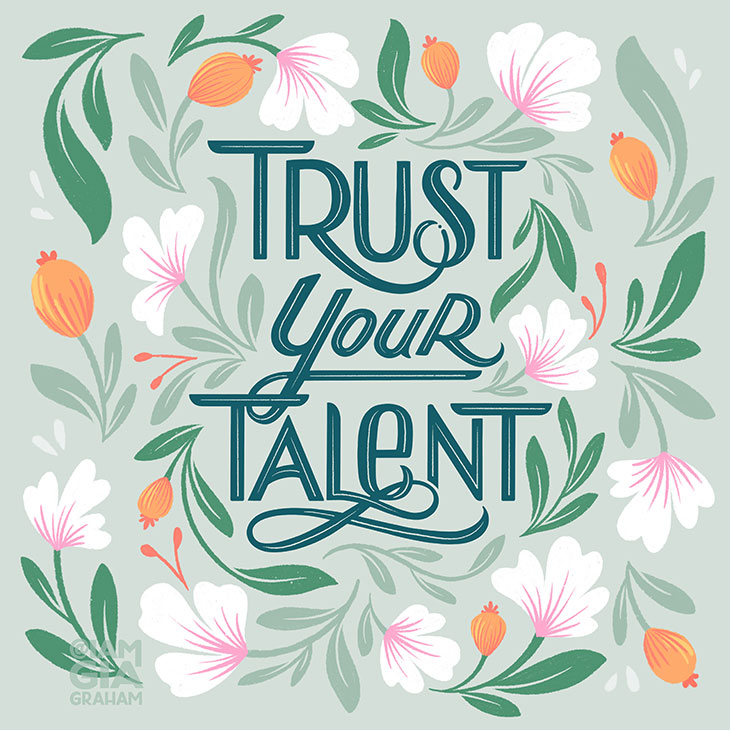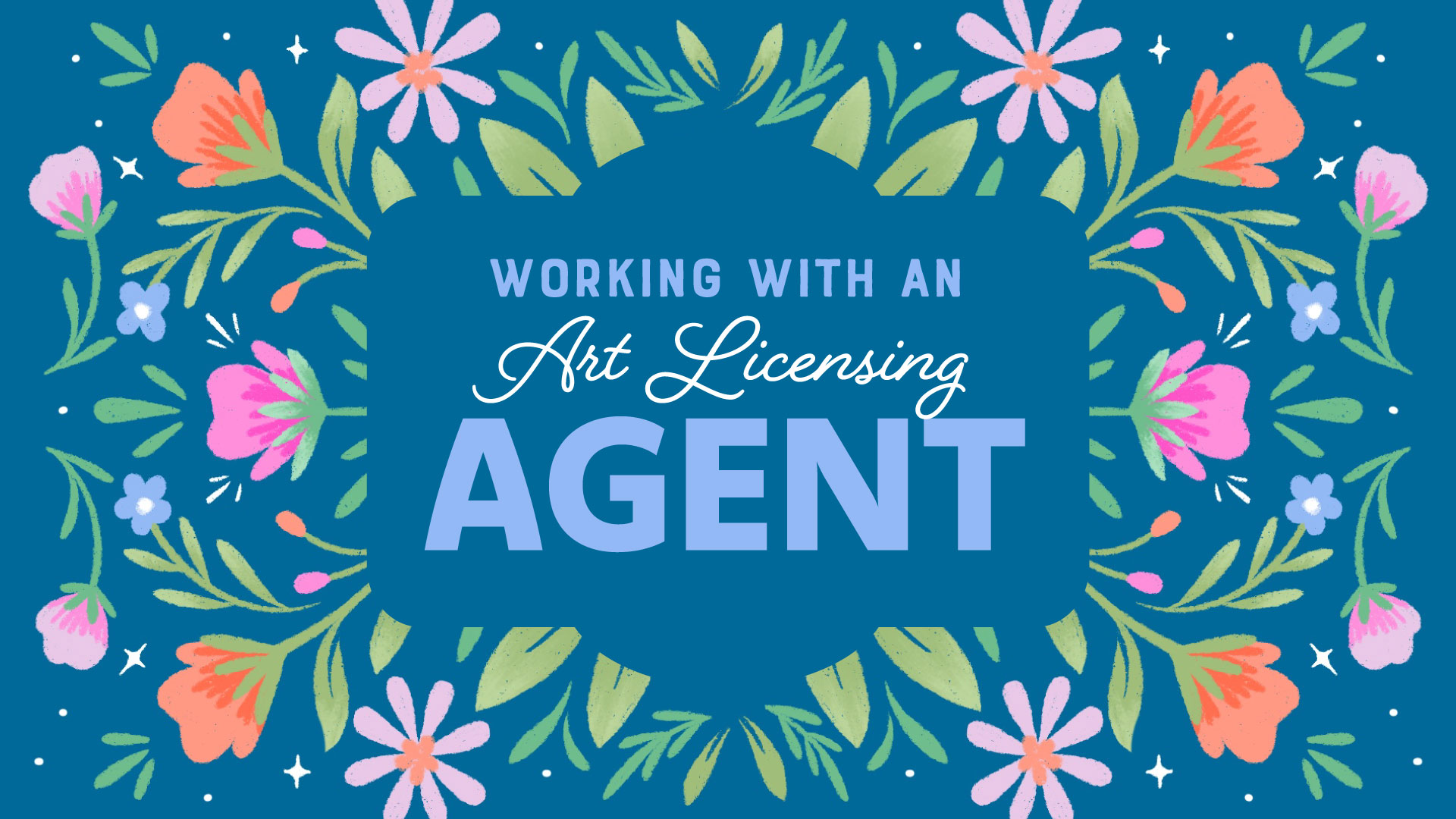If you aspire to become a commercial artist, one of the ways to connect with clients is to have an art agent. An agent can pitch your work, build relationships with clients on your behalf, negotiate deals and promote your portfolio. In many ways, they are a partner in your creative business.
There are different kinds of agents to fit different needs, depending on your niche. For example, an editorial agent connects illustrators with publishing companies seeking artwork for magazines covers, book covers, spot illustrations and other editorial projects.
A sales agent is the one to connect with if you have a product line featuring your artwork (stationery, greeting cards, gift items, etc.) and you want to get your products placed in retail stores.
If your focus is art licensing (also known as surface design), a licensing agent can pitch your work to manufacturers who put your art on products then distribute those products to retailers. If you’re not familiar with art licensing, in a nutshell, it’s when an artist grants a company permission to use their artwork on various products. The artist retains copyright of their work and when the products sell, the artist receives a percentage of the revenue, known as royalties.
I’ve personally had experience with two different kinds of agents. Back when I owned a stationery business, I worked with a sales agent, and now that I mainly focus on illustration, I work with Wild Apple Graphics, my licensing agent. If you’re considering working with a licensing agent, here are a few things you should know.

1. Build a solid portfolio.
Before reaching out to an agent, make sure your portfolio is ready and looks professional. Of course, Instagram is a great way to casually showcase your art but if you’re serious about working with an agent, you’ll need either a portfolio website or a well organized PDF portfolio which you can link to.
Unlike a typical artist portfolio which usually showcases individual pieces or projects, a licensing portfolio should showcase curated collections. Each collection can include 4-12 coordinating pieces ranging from hero images (full compositions) to simpler spot illustrations and repeat patterns. All of the art within a collection should share the same theme and color palette.
Something many new artists don’t consider is that licensing portfolios tend to be very large. I know established artists with over 3,000 pieces in their licensing portfolios. Yes. Three thousand. Obviously, that’s a huge number if you’re just starting out but you’ll still want to present several different collections in your portfolio if you’re interested in working with an agent. The reason for this is because licensing agents work with many clients, each with their own set of buying needs. An agent needs to know that you have a wide breadth of work they can present to those clients. A good starting point would be 6 collections, each with 10-12 pieces. That’s 60-72 pieces of art to start. Take your time. Build a quality portfolio you can be proud of.
2. Playing the long game.
‘Instant success’ isn’t really a thing with art licensing – even when you’re working with an agent. Licensing is a long game and it can take several months (or even years) before you see the fruits of your labor. There are a couple reasons for this:
• Some buyers prefer to take it slow. Sometimes an agent needs to pitch a new artist several times before a buyer decides to take a chance with someone new.
• More often than not, when your art does get picked up by a client, there is a long wait period between when you sign the contract and when the products hit shelves in retail stores and your royalty payments start to come in. It can be a slow process. Prepare to be patient.

3. Compatibility is key.
When you sign with an agent, you’re starting a long-term business relationship. Just like with any relationship, compatibility is key. Meet with a few different agents before you make a final decision. Ask lots of questions, get a feel for their personality and general vibe. Is this someone you actually like and would enjoy working with? Is their client roster a good fit your your style of work? Decide what your dealbreakers are and don’t ignore red flags!
4. Sharing the wealth.
Ok, ‘wealth’ might be a stretch. Although it is possible to earn a decent living through art licensing, it’s not exactly a golden ticket to untold riches. When considering working with an agent, one major factor to consider is that your agent gets a percentage of whatever you earn. Commission for a licensing agent can range anywhere from 30% to 50%. Some agents also charge an annual fee and/or showroom fees if you want to be included in the big trade shows.
Personally, I don’t mind paying the commission because my agent is really hands-on and manages so much on my behalf. They also have a large client roster and are able to score deals with buyers that I would not have access to otherwise.
On the other hand, I know a few artists who are great at doing the deep research to find buyers and pitch their own work. When those deals are successful, they are able to retain all of their earnings without having to share with an agent. Both options have their pros and cons – it just depends on what works best for you.
Note: Although I don’t mind paying the standard commission, I would advise you to be cautious about paying up-front annual fees and showroom fees in addition to the commission. These various fees can add up quickly and really cut into your earnings, especially if your agent isn’t bringing in enough deals for you to cover those costs. I learned that lesson the hard way many years ago.

5. Know what’s required.
Not all agents have the same expectations of their artists. Before signing with an agent, it’s important to know what will be required of you. Some agents expect you to produce 10-12 new pieces of art every month, while others defer to whatever creative cadence feels comfortable for you. Some agents expect you to create your own sales sheets for pitches while others handle that for you. Some smaller agencies require you to create your own cataloging system to keep track of all the artwork they rep for you, while larger agencies typically have their own cataloging system and just need you to send them your high resolution files. Some larger agencies have designers and art directors on staff who can handle minor artwork changes on your behalf (with your approval, of course) while other agencies require you to handle all change requests yourself. Every agency is different and you’ll need to make sure that their requirements align with what you’re willing to take on.
6. The more the better.
Even if your agent doesn’t require you to produce a specific amount of art each month, the opportunities for success increase when you add new art to your portfolio consistently. Buyers are always on the lookout for what’s fresh and new. Manufacturers create so much product that there is a constant need for new art and you’ll have a higher chance of getting licensing deals if your agent always has something new to show.
Of course, this can be challenging, especially if you are an artist juggling multiple streams of income (like most artists do), so you need to be careful to avoid burnout. This is a balancing act most surface designers grapple with, myself included. I think the key is to work smart and become efficient with your process so that you can be as consistent as possible over time, even if it’s challenging to be consistent day to day.

7. It’s always Christmas!
Holiday art sells. Licensing agents love when your portfolio is chock full of holiday art because buyers are always on the lookout for new art in this category. I struggled with this for a really long time because who wants to be thinking about Christmas is June?! As an artist who loves playing with color, I also found holiday art to be a bit too limiting from a color perspective (I love non-traditional holiday palettes but many buyers don’t). I’ve finally come to terms with the fact that I can’t escape it. This is one of those occasions where the business brain needs to overrule the artist brain. Holiday art is a huge part of art licensing and if you plan to work with an agent, you’re more than likely going to need lots of it in your portfolio.
8. Keep up with your contracts.
When you’re working with an agent who is handling negotiations and contracts on your behalf, it’s tempting to turn a blind eye to that part of the business because there are so many other things to think about. Unfortunately, I’ve seen other artists get burned by agents who didn’t have their best interest at heart. It’s really important to understand the contracts you’re signing, know which artwork is under license and know the terms and royalty percentages of each deal. If you want to receive samples of the products, ask to have that included in the contract. Ask what stores will carry the products if it’s not expressly stated. Make sure you’ll be credited on the products whenever possible. As mentioned above, your agent is essentially a partner in your business – you should feel comfortable enough to ask as many questions as you need to and they should be transparent with the information.

9. Don’t take it personally!
Rejection is part of the business but try not to take it personally. If you submit your art to an agency but you don’t get signed, it might not be due to lack of talent. It might simply be the wrong time or the wrong fit. When signing new artists, an agency needs to make sure the artist’s style will appeal to their clients and they need to make sure the new artist won’t be direct competition for another artists already on their roster. The same goes for clients. When your agent pitches your work, it might be rejected simply because it doesn’t fit the buyer’s particular needs at that particular time. Don’t be discouraged. Trust your talent and keep creating.
10. Be flexible.
Lastly, it’s important to be flexible. As artists, we often get really precious about our work, resistant to feedback or change. Agents will often ask artists to make changes to existing portfolio pieces in order to fit a client’s needs. Revise the color palette, change the orientation from vertical to horizontal, swap out one element for another… these are all common requests. Rather than becoming frustrated, remember than this is all part of the business of being a commercial artist. As long as the requested change doesn’t conflict with your ethics or fundamental beliefs, keep an open mind. Sometimes it works out for the best.
. . .
I hope these tips have given you a little insight on what it’s like to work with an art licensing agent! If you haven any questions, feel free to leave them in the comments below.
xo
Gia







